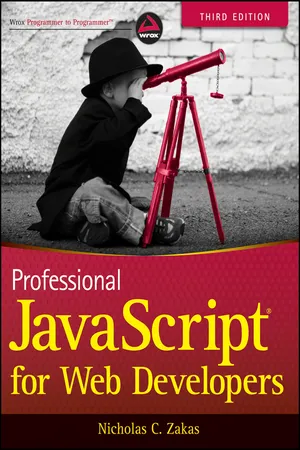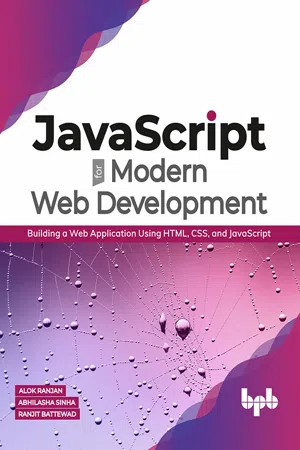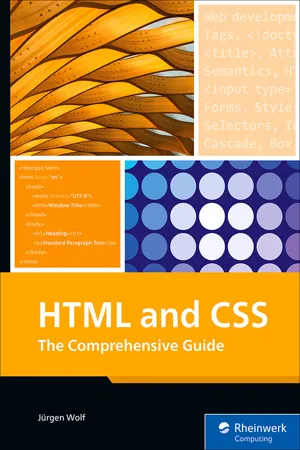Computer Science
Javascript Syntax
JavaScript syntax refers to the set of rules that define the structure and organization of JavaScript code. It includes elements such as variables, operators, and control structures, and follows a specific format for writing commands and instructions. Understanding and adhering to JavaScript syntax is crucial for writing functional and error-free code in web development and other applications.
Written by Perlego with AI-assistance
Related key terms
6 Key excerpts on "Javascript Syntax"
- eBook - ePub
- Matt Frisbie(Author)
- 2019(Publication Date)
- Wrox(Publisher)
3 Language BasicsWHAT'S IN THIS CHAPTER?
- Reviewing syntax
- Working with data types
- Working with flow-control statements
- Understanding functions
WROX.COM DOWNLOADS FOR THIS CHAPTER
Please note that all the code examples for this chapter are available as a part of this chapter's code download on the book's website at www.wrox.com/go/projavascript4e on the Download Code tab.At the core of any language is a description of how it should work at the most basic level. This description typically defines syntax, operators, data types, and built-in functionality upon which complex solutions can be built. As previously mentioned, ECMA-262 defines all of this information for JavaScript in the form of a pseudolanguage called ECMAScript.ECMAScript as defined in ECMA-262, fifth edition, is the most-implemented version among web browsers. The sixth edition is the next to be implemented in browsers, and as of the end of 2017, most major browsers have mostly or fully implemented the specification. For this reason, the following information is based primarily on ECMAScript as defined in the sixth edition.SYNTAX
ECMAScript's syntax borrows heavily from C and other C-like languages such as Java and Perl. Developers familiar with such languages should have an easy time picking up the somewhat looser syntax of ECMAScript.Case-Sensitivity
The first concept to understand is that everything is case-sensitive; variables, function names, and operators are all case-sensitive, meaning that a variable named test is different from a variable named Test . Similarly, typeof can't be the name of a function because it's a keyword (described in the next section); however, typeof is a perfectly valid function name.Identifiers
An identifier - eBook - ePub
Multimedia Web Design and Development
Using Languages to Build Dynamic Web Pages
- Theodor Richardson, Charles Thies(Authors)
- 2012(Publication Date)
- Mercury Learning and Information(Publisher)
client-side language, meaning all of the computations are done and actions are taken on the client’s Web browser.A programming language is a formal set of commands that can be used to manipulate data in a system; the programs using this kind of language are compiled and linked, turning the manually typed code into machine code prior to execution.A scripting language is a formal set of commands that can be used to manipulate data in a system; the scripts using this kind of language are written without the steps to compile and link them into machine code prior to execution.A client-side language, or front-end language, is a scripting or programming language that is executed on the local machine without involvement from the server. The client can view all source code.A server-side language , or back-end language, is a scripting or programming language that is executed on the server, where only the results of the computation are delivered to the client machine. In general, the client does not see the source code.Computational complexity is an estimate of how long it will take a program or a script to complete its operation. Syntax structures like loops and complex mathematics increase the complexity of a program or script. This can be measured in different units and is often a general estimate.A variable is a named placeholder representing a data value that may or may not change during execution.When JavaScript is invoked, the browser is using the computing resources of the local machine to process the information and compute the results. This means the server is not slowed down by this computation, but it also means the speed and efficiency of the script are determined by the state of the user’s machine, which is generally unknown. For this reason, JavaScript works best when it is concise and limited in computational complexity - No longer available |Learn more
- Nicholas C. Zakas(Author)
- 2011(Publication Date)
- Wrox(Publisher)
Chapter 3 Language Basics WHAT’S IN THIS CHAPTER?- Reviewing syntax
- Working with data types
- Working with flow-control statements
- Understanding functions
At the core of any language is a description of how it should work at the most basic level. This description typically defines syntax, operators, data types, and built-in functionality upon which complex solutions can be built. As previously mentioned, ECMA-262 defines all of this information for JavaScript in the form of a pseudolanguage called ECMAScript.ECMAScript as defined in ECMA-262, third edition, is the most-implemented version among web browsers. The fifth edition is the next to be implemented in browsers, though, as of the end of 2011, no browser has fully implemented it. For this reason the following information is based primarily on ECMAScript as defined in the third edition with changes in the fifth edition called out.SYNTAXECMAScript’s syntax borrows heavily from C and other C-like languages such as Java and Perl. Developers familiar with such languages should have an easy time picking up the somewhat looser syntax of ECMAScript.Case-sensitivityThe first concept to understand is that everything is case-sensitive; variables, function names, and operators are all case-sensitive, meaning that a variable named test is different from a variable named Test . Similarly, typeof can’t be the name of a function, because it’s a keyword (described in the next section); however, typeOf is a perfectly valid function name.IdentifiersAn identifier - eBook - ePub
JavaScript for Modern Web Development
Building a Web Application Using HTML, CSS, and JavaScript
- Alok Ranjan(Author)
- 2020(Publication Date)
- BPB Publications(Publisher)
Let's delve into learning JavaScript, which is the backbone of the web. When learning a new language, always start with the basics.Building blocks of JS
You will now learn about the basic syntax and building blocks of the JavaScript scripting language. The building blocks of JS mainly include the following:- Variables
- Data Types
- Statements
- Functions
Variables
Variables are identifiers used to store the data and information related to the application. Variables are needed in any programming language to hold values of different types, computation results, etc.Variables can be defined using the below keywords (this includes the latest approach of defining variables as per ES6):- let: This is the recommended way of defining variables that remain valid in the block in which it is defined, and its value can be changed and reassigned. A block is defined as a set of lines of code enclosed within a pair of parentheses, so it could be a for loop, an if statement, a function, any block of code within a pair of parentheses. let name; let age; let num1,num2,num3;
- const: This is used whenever the containing value is constant and will not undergo change. This is also block scoped. This is the recommended way of defining if you are sure that your variable value should not be changed as it will ensure that it does not get overwritten even by mistake. const pi=3.14;
- eBook - ePub
- Mike McGrath(Author)
- 2020(Publication Date)
- In Easy Steps Limited(Publisher)
prototype. Standard JavaScript objects, such as functions, call an internal constructor function to create the object by defining its components.Don’t worry if you can’t immediately understand how closures work. They can seem mystical at first, but will become clearer with experience. You can continue on and come back to this technique later.Summary• JavaScript code can be included in an HTML document directly or from an external file using <script> </script> tags.• JavaScript can display output in an HTML element in an alert dialog box or in the browser’s console window.• JavaScript statements may contain keywords, operators, values, and expressions.• The JavaScript interpreter ignores tabs and spaces.• JavaScript statements can be grouped in { } curly bracket function blocks that can be called to execute when required.• Variable and function names may comprise letters, numbers, and underscore characters, but must avoid keywords.• JavaScript variables may contain data types of String, Number, Boolean, Object, Function, Symbol, null , and undefined .• Variables declared with the let keyword can be reassigned new values, but the const keyword does not allow this.• A function expression has statements grouped in { } curly brackets for execution, and it returns a final single value.• The ( ) parentheses of a function expression may contain parameters for argument values to be passed from the caller.• A function block can include a return - eBook - ePub
HTML and CSS
The Comprehensive Guide
- Jürgen Wolf(Author)
- 2023(Publication Date)
- SAP PRESS(Publisher)
17 A Brief Introduction to JavaScript
JavaScript, Ajax, and jQuery are often mentioned in the same breath in the context of web development. For beginners, it’s often frustrating to be confronted with many different terms. In this chapter, you’ll first get to know some basics about JavaScript as a programming language.When it comes to web development, JavaScript has become indispensable. While you can use HTML to create the content of your website and CSS to design the layout and formatting, you’re still missing a way to dynamically influence the behavior of a website within the web browser. JavaScript enables you to perform Document Object Model (DOM) manipulations such as changing HTML elements, HTML attributes, and HTML styles, as well as checking entered data in HTML forms for correctness. Let’s not forget the now numerous JavaScript application programming interfaces (APIs; also called web APIs) in HTML. Even for the use of many frameworks, such as React, Angular, or Vue.js, you can’t get around sound JavaScript knowledge.This chapter is intended to give you a basic and simple introduction to the world of JavaScript. To avoid raising false hopes here, I should mention that this chapter will only introduce you to JavaScript as a scripting language. JavaScript is a programming language that can’t be described quickly in its entirety within one chapter. The introduction to JavaScript in this book only goes so far as to let you use JavaScript for client-side applications of the DOM, the interfaces between HTML, and dynamic JavaScript—more specifically—you’ll learn how to write programs that run in the web browser.Not only is JavaScript now suitable for client-side applications, as described in this book, but the language has become very versatile. For example, JavaScript is also used today for server-side applications, desktop applications, mobile applications, and even embedded applications. Even games and 3D applications can now be developed with JavaScript. However, this is only mentioned here in passing to show you that, with JavaScript, you learn a fairly ubiquitous language that can be used not only in the web browser.
Index pages curate the most relevant extracts from our library of academic textbooks. They’ve been created using an in-house natural language model (NLM), each adding context and meaning to key research topics.





